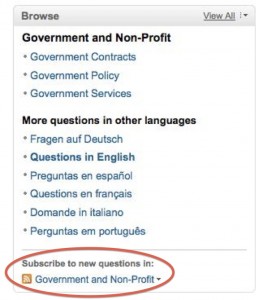On networking for business
We see, hear, read ad nauseam about how we should network to grow our businesses.
Image: USACE Europe District, Creative Commons
Too often, though, I think people take that to mean going to innumerable tweetups, happy hours and the ilk. I’ve lost count of the number of people I’ve seen over-commit themselves to multiple networking events on the same night.
The end result is usually that they’re tired, over-extend themselves which they later regret, and sometimes do things they later feel sheepish about.
I, by the way, NEVER do things I later feel sheepish about.
I embrace my sheepishness from the get-go.
At any rate, I think networking events and tweetups are great.
I go to those that I can (I went to one last night and had a great time) but, frankly, I am a no-show at several more.
I know what you’re thinking. “She’s anti-social!”
Not at all.
And those of you who’ve met me know this. It’s not that I don’t want to meet new people””I love meeting new people.
I just recognize that there is a threshold beyond which some events are not productive for me, personally or professionally.
And if I’m not feeling my best at these events, you’re not going enjoy meeting or talking to me either.
See? Quite logical.
Networking with a twist
Outside of the gazillion networking events our calendars get crammed with””and there are some terrific ones out there””here are three ways to network with a twist that will grow your business.
I’ve experienced all of these at one point or another in my career, and again in rapid succession this past week.
I was so taken aback by how this “twisty networking thing” really works, that I went “Whoa!”
My dog, who knows exactly how to keep me in line, said, “Whatever, you’re not that special,” rolled over and went back to sleep.
Thanks a bunch, Suzy.
So I wanted to share. ‘Cos I am like this only (a genius Indian saying we can all thank Channel V for).
1. Stay on the recruiter radar.
Usually we don’t think of recruiters as possible clients or as part of our business development process.
This is pretty stupid because good recruiters are some of the most connected people in the industry. They have to be. Their livelihood depends on it.
I’ve come across my share of bad recruiters, but the good ones are like gold.
Why? They understand the importance of networking and paying it forward and usually have memories longer than elephants.
When you make a good impression on them, they remember you.
Sometimes they have project-based work come their way – and don’t you want them thinking of you when it does? Or, they leave their recruitment firms and end up sourcing new hires for a new firm.
Helloo!! That often includes consultants and independent practitioners.
So: If you had a good rapport with them, connect on LinkedIn, Twitter and any other social networks where it makes sense. Make sure your profile stays up to date and “feed” your profile with your Twitter feed, blog posts, presentations, etc.
I believe this is particularly important for LinkedIn, though I think you should do a periodic sweep of all your networks, to make sure the information about you is up to date.
Be of help if they approach you for a search they are conducting. Connect them with someone you feel confident recommending.
One day – and I can’t tell you when, but I can tell you that it will happen – they will come back to you with a project that’s right up your alley and bingo! You have a new client.
2. A the LinkedIn Q & A.
There are a couple ways of doing this (possibly more, but these are two I’ve seen).
The first
is to join a group and mine its discussion forums, contributing thoughtfully when you can… and I don’t mean plugging your blog posts with scant regard to how spammy that might seem.
The second
is to set up an RSS feed for questions related to your area of expertise that are being asked on LinkedIn (and as you probably know, you can get alerts for your group updates, as in the first option above, sent to your email as well).
 Just select “Answers” in the drop-down menu to the left of the search box, find the topics you’re interested in, and then click on the RSS option, as at left.
Just select “Answers” in the drop-down menu to the left of the search box, find the topics you’re interested in, and then click on the RSS option, as at left.
Yes, you will invariably find some that make you grit your teeth and wonder why so-and-so-with-usually-a-quote-unquote-decade-or-two-of-experience-or-so-they-say is asking something so basic you wonder whether she even understands what the dictionary definition of “expert” is.
But maybe there’s an educational opportunity here that could result in social karma down the road.
If you find what you think are really silly questions, though, ignore them, as well as the questions that are thinly veiled attempts at getting free consulting advice.
But those that are genuine requests for advice or sincere attempts to learn more? Go for ’em.
Just make sure you’re really adding value to the discussion at hand.
Bonus tip: if you find that 23 other people have already beaten you to the punch, don’t bother, unless you really have something original to say. Stay alert for the next opportunity and get in there as quickly as you can.
Now you’re thinking, “Hang on. There’s nothing new about that. Isn’t business development and building their network the main reasons people volunteer with an association in the first place?”
Maybe, but it wasn’t for me. Every time I’ve gotten involved as a volunteer with an association, I’ve done it because I really enjoy the service aspect of it.
(That’s me at an IABC/DC Metro event with @amylizmartin and @SunainaTweets.)
What’s important is to really do stuff. Not just show up.
When you’re active and entrepreneurial in your voluntary leadership role, something funny starts happening.
Your colleagues on your board…
give you unsolicited recommendations.
People you’ve never heard of…
reach out to you because they recognize your commitment to the profession.
New business leads…
are forwarded to you from listservs you ordinarily wouldn’t have access to””and sometimes they’re even followed up by personal introductions made for you.
Why?
Because they’ve seen you in action.
They’ve seen your leadership style and your ability to manage an often far-too-large team.
They’ve seen how you handle conflict, and whether or not you try to come up with solutions.
They’ve experienced whether or not you really encourage creativity (regardless of what your resume says), whether you’re willing to say “no” diplomatically when the need arises, and whether you’re willing to give credit where credit is due.
All. These. Are. Things. Clients. Look. For. In. Their. External. Partners.
The key to all of this, of course, is to keep it real.
Be nice to people. Don’t indulge in SSP (shameless self-promotion). Make and maintain good relationships without expecting anything in return.
It will surprise you how quickly you come full circle.
Those are just three subtle ways of giving a new dimension to networking that will keep your business development funnel open and build your client base.
What has worked for you? Do share, I’d love to know.




![[EVENT]: PR Hacks for Small Biz (online)](https://shonaliburke.com/wp-content/uploads/2021/06/FB-Ad-1200x800-01-01-01-Copy-500x383.jpeg)








[…] rather take 50 with me and make solid connections that I think will bear fruit; and if I give only 10 of those out, I’m fine with that because I know those 10 people will […]
[…] send mostly birthday greetings to my friends, family and business contacts, which is another way of networking with a twist. This was one of the reasons I signed up for Plaxo’s premium service some years ago. I figured […]
[…] In my opinion, there is a huge difference here. Attracting new business isn’t all that tough, particularly if you’re the kind of person who networks with a twist. […]
[…] rather take 50 with me and make solid connections that I think will bear fruit; and if I give only 10 of those out, I’m fine with that because I know those 10 people will […]
[…] why I wrote about networking with a twist a while back. Because there is only so much time in the day and, try as I might, I just can’t […]
[…] The other thing I really like about Plaxo’s offerings are its ecards. I use them all the time to schedule and send mostly birthday greetings to my friends, family and business contacts, which is another way of networking with a twist. […]
[…] 10. Eat, drink and be merry.9. Do the above and then do some networking with a twist. […]
[…] 9. Do the above and then do some networking with a twist. […]
Excellent ideas all! But especially like your reminder about the value of good recruiters. The great ones really are well-connected and use their connections to help each other regularly. And frankly, knowing the best recruiters in your own field helps you keep up with your industry — good intel is always valuable!
Great post! Thanks
Thanks, Patra! Much like PR pros, I think HR pros are much-maligned, but the gems are unbeatable.
This is a timely piece for me, Shonali. I’m evaluating all of my activities, whether we call them “networking” or merely participating in events, I’ve not seen the sort of return that I expected from that participation. I recall when I was on the corporate side that many networking events were little more than a host of vendors and consultants, trying desperately to get me to take their calls. Meanwhile, I was trying to figure out how to do my work with 20% less budget and one less staffer.
Now, I’m “expanding the network” and building relationships that hopefully, one day, might result in an assignment. It’s a lengthy process filled with frustration… But I have met a bunch of nice people, so I’ve got that going for me!
thanks for writing this.
S
Adding nice people to your circle is always a plus, Sean. It’s fascinating to me how these relationships work. I don’t know if there’s a magic formula for building them – much less anything else – but being nice is a good way to start.
I have a confession to make I hate networking. It can be traced to my early corporate career when we attended cattle call meetings where they served stale doughnuts and bad coffee or some form of chicken. “Networkers” with painted on smiles and shiny shoes would size me up, as I watched their limbs twitch while their brains drew lines of connections as they decided if it was worth the effort to remember my name. I much prefer good old fashioned socializing. I like people, I like their stories, I like getting to know them. I also like helping and offer my knowledge and time wisely but freely. Maybe I’m a peopleworker but I am a horrible networker.
That is such a thoughtful comment, Karen. Truth be told, I’ve been uncomfortable at many such events because of all these reasons.
I don’t think “networking” is just “getting your name out there.” One of the questions we’re told to ask when we meet new people is, “How can I help you?”
To me, that’s jumping the gun. Let’s face it, we don’t WANT to help everyone we meet. And that doesn’t mean we’re bad people. Those we want to help at some point are those who’ve done something nice for us, who’ve taken the time to get to know us.
My guess is that you’re actually a really good networker but in the true sense of the word, not as it’s been bastardized by corporate culture.
Love the Indian anecdote! ;)
Also love that you highlight the importance of truly being sincere and nice to people without expecting anything in return.
Great post as always, Shonali!
Well, you can take the girl out of India, but you can’t take India out of the girl, right, Sunaina?!
[…] This post was mentioned on Twitter by Shonali Burke and Shonali Burke, Shonali Burke. Shonali Burke said: New post: Business Bootcamp for PR pros (on networking with a twist): http://t.co/Qr9d2jz (I write from personal experience!). #pr @solopr […]